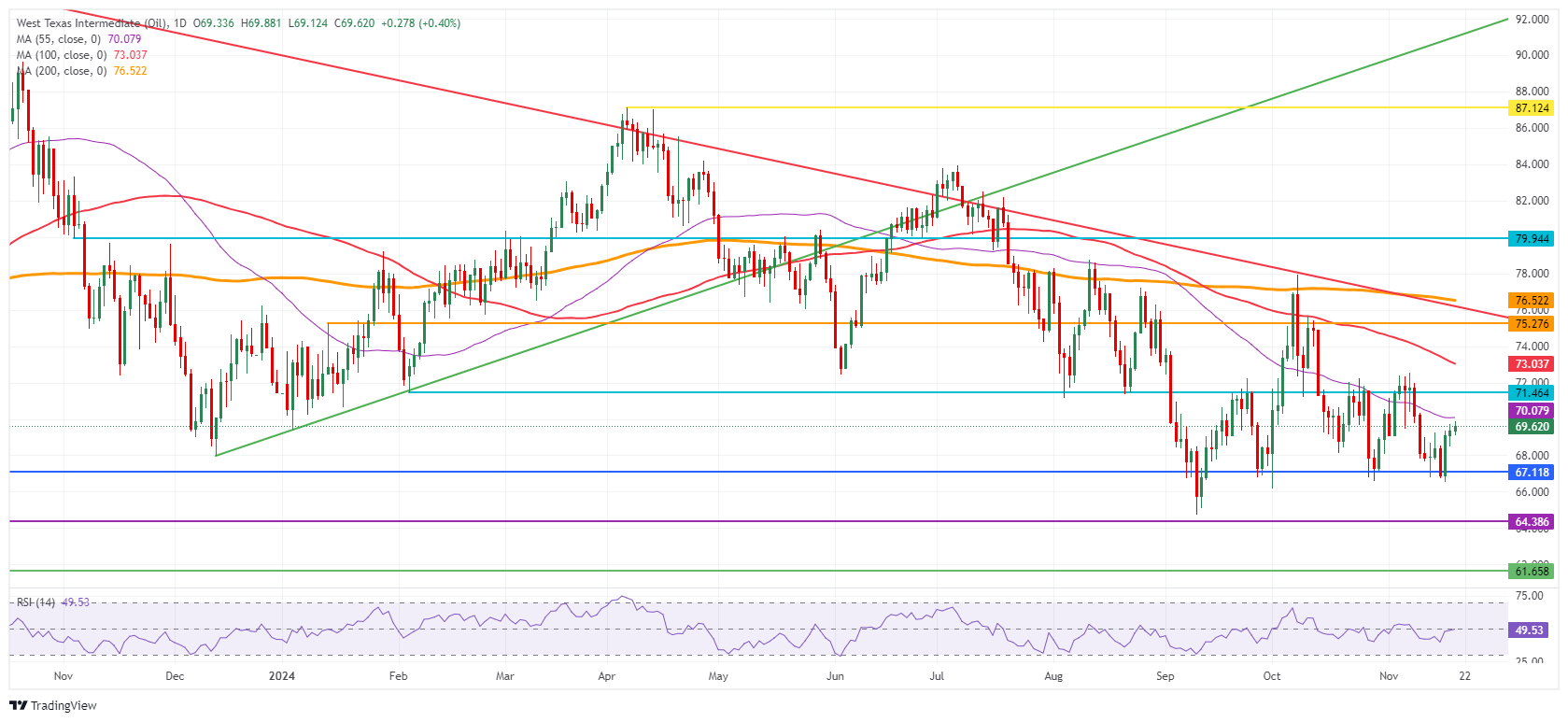Crude Oil ticks up as geopolitical tensions trigger supply concerns
Fxstreet
Nov 20, 2024 1:19 PM
- Crude Oil edges higher for a third day in a row backed by geopolitical tensions.
- Headlines risk in the Russia and Ukraine war points to further escalation ahead.
- The US Dollar Index recovers with traders bracing for Nvidia earnings after the US closing bell.
Crude Oil prices are ripping higher for a third day in a row on Wednesday, getting close to the $70 round level, as geopolitical tensions – namely the escalation in the war between Russia and Ukraine – take over market sentiment to the detriment of stockpile data.
That element became very clear after the release from the American Petroleum Institute (API) US stockpile data on Tuesday, which showed a big buildup of 4.753 million barrels. Such a big increase in inventories should weigh on Oil prices, but markets largely ignored the data due to headlines pointing to increased tensions between Ukraine and Russia.
Meanwhile, the US Dollar Index (DXY) is edging up slightly with all eyes towards Nvidia earnings later on Wednesday. Equities are on the front foot and the US Dollar is also supported. Traders will also hear comments from four Federal Reserve (Fed) officials.
At the time of writing, Crude Oil (WTI) trades at $69.57 and Brent Crude at $73.36.
Oil news and market movers: API and EIA data ignored
- Near 15:30 GMT, the Energy Information Administration (EIA) will release its weekly Crude stockpile change numbers. The forecast is for a small build of 0.4 million barrels against the build of 2.089 million barrels reported last week.
- The American Petroleum Institute (API) released its weekly Crude stockpile change numbers for the week ending November 15 on Tuesday. A firm build of 4.753 million barrels was reported, well above the forecast of 0.8 million barrels and against the drawdown of 0.777 million the previous week.
- Norway's Equinor said on Wednesday that it restored full output capacity at the Johan Sverdrup oilfield in the North Sea following a power outage, Reuters reports.
Oil Technical Analysis: Limited potential for this rally
Crude Oil price might be ticking up, supported by the geopolitical tensions between Russia and Ukraine. Still, markets seem to be taking these moves with a pinch of salt as the actual Oil market is still very much flooded with more supply than demand. So, the overall longer term outlook has not changed.
On the upside, the 55-day Simple Moving Average (SMA) at $70.07 is the first barrier to consider before the hefty technical level at $73.04, which aligns with the 100-day SMA. The 200-day SMA at $76.52 is still quite far off, although it could be tested if tensions intensify further.
On the other side, traders need to look towards $67.12 – a level that held the price in May and June 2023 – to find the first support. In case that breaks, the 2024 year-to-date low emerges at $64.75, followed by $64.38, the low from 2023.

US WTI Crude Oil: Daily Chart
WTI Oil FAQs
WTI Oil is a type of Crude Oil sold on international markets. The WTI stands for West Texas Intermediate, one of three major types including Brent and Dubai Crude. WTI is also referred to as “light” and “sweet” because of its relatively low gravity and sulfur content respectively. It is considered a high quality Oil that is easily refined. It is sourced in the United States and distributed via the Cushing hub, which is considered “The Pipeline Crossroads of the World”. It is a benchmark for the Oil market and WTI price is frequently quoted in the media.
Like all assets, supply and demand are the key drivers of WTI Oil price. As such, global growth can be a driver of increased demand and vice versa for weak global growth. Political instability, wars, and sanctions can disrupt supply and impact prices. The decisions of OPEC, a group of major Oil-producing countries, is another key driver of price. The value of the US Dollar influences the price of WTI Crude Oil, since Oil is predominantly traded in US Dollars, thus a weaker US Dollar can make Oil more affordable and vice versa.
The weekly Oil inventory reports published by the American Petroleum Institute (API) and the Energy Information Agency (EIA) impact the price of WTI Oil. Changes in inventories reflect fluctuating supply and demand. If the data shows a drop in inventories it can indicate increased demand, pushing up Oil price. Higher inventories can reflect increased supply, pushing down prices. API’s report is published every Tuesday and EIA’s the day after. Their results are usually similar, falling within 1% of each other 75% of the time. The EIA data is considered more reliable, since it is a government agency.
OPEC (Organization of the Petroleum Exporting Countries) is a group of 12 Oil-producing nations who collectively decide production quotas for member countries at twice-yearly meetings. Their decisions often impact WTI Oil prices. When OPEC decides to lower quotas, it can tighten supply, pushing up Oil prices. When OPEC increases production, it has the opposite effect. OPEC+ refers to an expanded group that includes ten extra non-OPEC members, the most notable of which is Russia.




